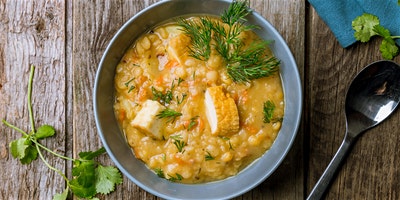from Farm Table instructor Terry Kelzer

Swedish Yellow Pea Soup (Ärtsoppa)
Ingredients
- 1 pound whole dried yellow peas
- 8 cups water or chicken broth—or some combination of same
- 2 finely chopped onions (2 cups)
- 1 large chopped carrot (½ cup)
- 1 pound of cut up ham, or ham bone, or 2 to 3 ham hocks
- 1 teaspoon dried thyme
- 1 teaspoon ground marjoram
- 1 teaspoon salt
- ½ teaspoon pepper
- 1 teaspoon Swedish mustard, or Dijon, or a spicier mustard if you prefer
Instructions
- Rinse and pick through 1 pound of dried yellow peas. Soak the peas overnight in water; cover by about 2 inches.
- Fill a large pot with 8 cups of water—or 6 cups chicken broth and 2 cups water. Add the drained peas.
- In a separate pan sauté 2 finely chopped onions and 1 large chopped carrot. Add to soup pot along with the ham or a meaty ham bone (or 2 to 3 ham hocks).
- Bring to a boil, skimming off any foam; then cover pot and reduce to a simmer over low heat for 90 minutes.
- Skim off any pea skins that have risen to the surface. Remove 2 to 3 cups of the soup, puree in a blender or food processor, and return puree to the pot.
- Continue to simmer for at least 60 more minutes, or more until peas are tender.
- 30 minutes before serving (if using ham hocks or bone-in-ham), cut off meat. Chop the meat and return to pot.
- Season the soup with 1 teaspoon dried thyme and dried marjoram; salt and pepper to taste.
Note: Add the mustard to the pot before serving, or serve it on the side.
Swedish Pancakes (Pannkakor)
Ingredients
- 3 tablespoons butter, plus more for cooking
- 2 cups milk
- 1 cup all-purpose flour
- 3 large eggs
- 1 tablespoon granulated sugar
- ¼ teaspoon kosher salt
Optional ingredients: 1 teaspoon vanilla; 1/4 cup sparkling water
Instructions
- Mix half the milk and eggs in a bowl. Add flour and salt. Add melted butter. Add optional vanilla or sparkling water. Mix until there are no lumps; you may use blender or food processor. Rest for 30 minutes.
- Heat a frying pan over medium heat on the stovetop. Stir the batter well again and then pour a thin layer (about ½ cup) into the pan, swirling around to coat. (The batter should make a sizzling sound when it’s first poured in; if it doesn’t, the pan is not hot enough.)
- When the edges of the pancake are curling and browning, and the top has gone from shiny to matte, check the bottom of the pancake to see if it’s ready to flip. Flip the pancake when the color has reached a light golden brown. Cook the second side until it also is a light golden brown, then set aside.
- Repeat the steps above until all of the batter is used, making sure to stir the batter before each new pancake is poured as the flour will sink to the bottom otherwise.
- Roll or fold pancakes into triangles
Notes: If your pancake is bubbling excessively when you flip it, the batter is too thick, so pour less batter for the next pancake. The first pancake is the most difficult to get right—use this “test pancake” to adjust both the amount of batter needed and the temperature of the pan. Pannkakor are very thin and therefore cool quickly, so they are usually eaten at room temperature. Lingonberry is the traditional topping for pannkakor but these days you can find a variety of toppings, including whipped cream and other berries.
